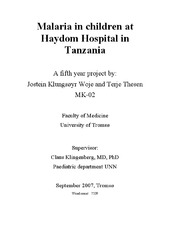| dc.description.abstract | Background:
Malaria is a parasitic disease which kills somewhere between 0.5 to 3.0 million people each year, 75% of these are children under the age of five. The most affected region is sub-Saharan Africa. Our aim was to study malaria in children admitted at Haydom Lutheran Hospital (HLH), which is remotely situated in the Mbulu district in northern Tanzania. The hospital covers an area with around 440 000 people and malaria is endemic in this area.
Material and methods:
We conducted a follow up study in a period from 27.06.06 to 17.07.06 where we registered all patients below five years of age who were admitted with fever or other possible symptoms of malaria, and all children treated with quinine. The following data were registered: age, sex, length of admission, blood slide, fever, Hb, treatment and symptoms and outcome.
Results/Discussion:
191 patients were included during the 3 week study period. The median age of the patients was 8 months and median admission length was 5 days. 12 of 191 patients died (6% mortality).
72 children received a final clinical diagnosis of malaria, before considering the results of the blood slide. However, only 14 of 72 (19 %) had a positive malaria blood slide. 119 patients received different non-malaria diagnoses, but 7 (6 %) of these also had positive blood slide.
There are significantly more positive blood slides in the group with the final clinical diagnosis of malaria compared to the rest of the patients (p <0.001), indicating that clinicians may recognize malaria clinically in 2/3 of all blood slide positive cases. 1/3 of the patients with positive blood slide did not receive a malaria diagnosis, still all of them received antimalaria treatment. In total 21 out of 185 patients had positive blood slide, which is lower than expected in an endemic area. However the registration was done in the dry season when the prevalence malaria in this area is fairly low. Many of the children were very young, and because of immunity due to maternal transfer of malaria antibodies they are not highly susceptible to get malaria.
Despite the outcome of the lab results, the clinical state of the child was the most important criteria for starting treatment. The time from admission and start of treatment to the lab results arriving at the ward varied much and did not influence the anti malaria treatment. Since the decision was made to treat with antimalaria based on the clinical state of the child, it is correct to finish the treatment even if lab results later could not confirm the malaria diagnose.
29 patients without the malaria diagnose got antimalaria treatment. This suggests that the use of quinine was liberal at HLH. Over treatment with antimalarias can cause drug resistance and it is considered a major problem in Africa. | en |


 English
English norsk
norsk